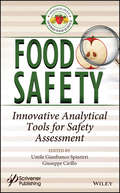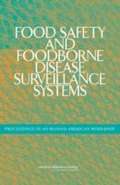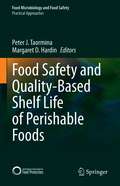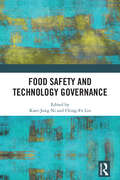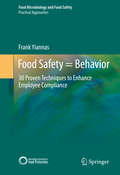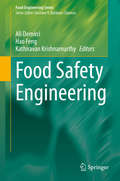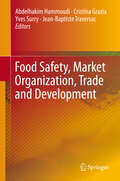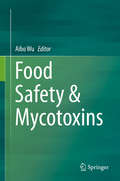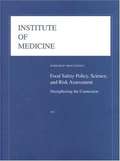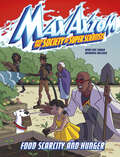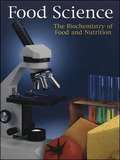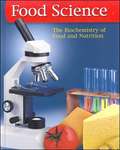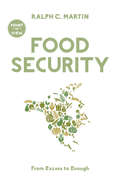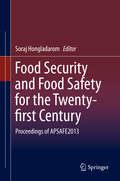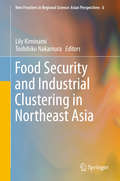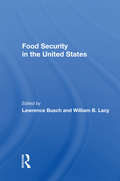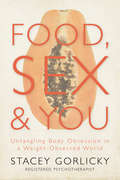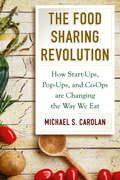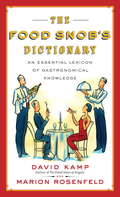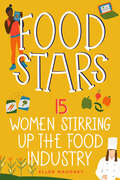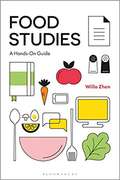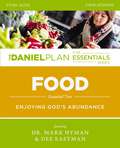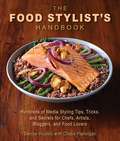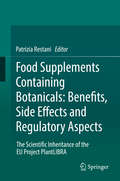- Table View
- List View
Food Safety: Innovative Analytical Tools for Safety Assessment
by Umile Gianfranco Spizzirri Giuseppe CrilloFood safety and quality are key objectives for food scientists and industries all over the world. To achieve this goal, several analytical techniques (based on both destructive detection and nondestructive detection) have been proposed to fit the government regulations. The book aims to cover all the analytical aspects of the food quality and safety assessment. For this purpose, the volume describes the most relevant techniques employed for the determination of the major food components (e.g. protein, polysaccharides, lipds, vitamins, etc.), with peculiar attention to the recent development in the field. Furthermore, the evaluation of the risk associated with food consumption is performed by exploring the recent advances in the detection of the key food contaminants (e.g. biogenic amines, pesticides, toxins, etc.). Chapters tackle such subject as: GMO Analysis Methods in Food Current Analytical Techniques for the Analysis of Food Lipids Analytical Methods for the Analysis of Sweeteners in Food Analytical Methods for Pesticides Detection in Foodstuffs Food and Viral Contamination Application of Biosensors to Food Analysis
Food Safety And Foodborne Disease Surveillance Systems: Proceedings Of An Iranian-american Workshop
by National Research Council of the National AcademiesIn October 2004 the Research Center for Gastroenterology and Liver Diseases of Shaheed Beheshti University hosted in Tehran an Iranian-American workshop on Food Safety and Surveillance Systems for Foodborne Diseases. The purposes of the workshop were to initiate contacts between Iranian and American specialists, exchange information about relevant activities in the two countries, and set the stage for future cooperation in the field. The participants also identified important aspects of food safety that should be addressed more intensively by both countries, including surveillance, research, international trade, and risk assessment. The framework for the workshop had been developed during a meeting of Iranian and American specialists in June 2003 in Les Treilles, France. More that 100 specialists participated in the workshop in their personal capacities, along with representatives of the World Health Organization and the Food and Agriculture Organization. These proceedings include a number of papers that were presented at the workshop together with summaries of discussions following presentation of the papers.
Food Safety and Quality-Based Shelf Life of Perishable Foods (Food Microbiology and Food Safety)
by Peter J. Taormina Margaret D. HardinThis book addresses the shelf life of foods, a key factor in determining how food is distributed and consequently where and when different food products are available for consumption. Shelf life is determined by several factors, including microbiological, chemical, physical, and organoleptic deterioration. Often these factors are interrelated and interdependent. The editors of this volume focus specifically on the microbial factors related to shelf life of perishable foods and food commodities. This allows for more detailed coverage of foodborne bacterial pathogens and spoilage microorganisms of concern. The initial part of the book covers the why and how of shelf life determination as well as the specific microbial pathogens and spoilage microorganisms of concern for perishable foods. Contributors address topics such as the techniques utilized for determination of shelf life, the frequency of shelf life testing for different products, the interpretation of data to make shelf life determinations, and management of shelf life of food products from the perspective of the food producer, distributor, retailer, and regulator. Three key areas impacting shelf life are addressed in detail: sanitation, processing, and packaging. The sanitation chapter explains the necessary components of cleaning and sanitizing to assure a hygienic processing environment and why that is critical to shelf life control. Traditional processing procedures are reviewed and advanced processing technologies are explored. Materials used in food packaging and the utilization of traditional and activated food packaging by product type are covered in detail. The latter two chapters of the book delve into newer techniques of analysis and explore the microbiome of food products. Implications of microbial ecology and microbial quantification in food products are discussed in chapters on genomics and in the changing dogma of meat shelf life. The primary audience for this work includes food industry quality and food safety technicians, managers, directors, and executives responsible for shelf life. Academicians and governmental researchers involved in research and teaching about food safety and quality will also find the material relevant and useful.
Food Safety and Technology Governance
by Kuei-Jung Ni Ching-Fu LinRecent advances in agri-food technology have brought about increasing complexity and emerging challenges to food safety regulation and governance, with many countries greatly divided in their regulatory approaches. As more advanced CRISPR based gene-editing technologies, and novel foods such as cloned animal products, non-traditional plants, nanofood, and plant-based meat are rapidly being developed, debates arise as to whether the existing models of governance require revision to ensure consumer safety. Of equal importance is the extensive use of pesticides, additives, and animal drugs which raise concerns over the methods and approaches of government approval and phasing out of potentially risk-causing chemicals. Heightened public criticism of food safety and technology poses a significant challenge to governments around the world, which struggle to strike a proper balance between technocracy- and democracy-oriented risk governance models. Drawing on expertise from the United States, European Union, Japan, China, Korea, Association of South East Asian Nations, Malaysia, and Taiwan, this book explores existing and emerging issues of food law and policy in the context of technology governance to offer an overarching framework for the interaction between food regulation and technology. It will be essential reading for academics, students and practitioners with an interest in food law and policy, agricultural law and policy and food safety and nutrition studies.
Food Safety = Behavior
by Frank YiannasThis book helps in Achieving food safety success which requires going beyond traditional training, testing, and inspectional approaches to managing risks. It requires a better understanding of the human dimensions of food safety. In the field of food safety today, much is documented about specific microbes, time/temperature processes, post-process contamination, and HACCP-things often called the hard sciences. There is not much published or discussed related to human behavior-often referred to as the "soft stuff. " However, looking at foodborne disease trends over the past few decades and published regulatory out-of-compliance rates of food safety risk factors, it's clear that the soft stuff is still the hard stuff. Despite the fact that thousands of employees have been trained in food safety around the world, millions have been spent globally on food safety research, and countless inspections and tests have been performed at home and abroad, food safety remains a significant public health challenge. Why is that? Because to improve food safety, we must realize that it's more than just food science; it's the behavioral sciences, too. In fact, simply put, food safety equals behavior. This is the fundamental principle of this book. If you are trying to improve the food safety performance of a retail or food service establishment, an organization with thousands of employees, or a local community, what you are really trying to do is change people's behavior. The ability to influence human behavior is well documented in the behavioral and social sciences. However, significant contributions to the scientific literature in the field of food safety are noticeably absent. This book will help advance the science by being the first significant collection of 50 proven behavioral science techniques, and be the first to show how these techniques can be applied to enhance employee compliance with desired food safety behaviors and make food safety the social norm in any organization.
Food Safety Engineering (Food Engineering Series)
by Hao Feng Ali Demirci Kathiravan KrishnamurthyFood Safety Engineering is the first reference work to provide up-to-date coverage of the advanced technologies and strategies for the engineering of safe foods. Researchers, laboratory staff and food industry professionals with an interest in food engineering safety will find a singular source containing all of the needed information required to understand this rapidly advancing topic. The text lays a solid foundation for solving microbial food safety problems, developing advanced thermal and non-thermal technologies, designing food safety preventive control processes and sustainable operation of the food safety preventive control processes. The first section of chapters presents a comprehensive overview of food microbiology from foodborne pathogens to detection methods. The next section focuses on preventative practices, detailing all of the major manufacturing processes assuring the safety of foods including Good Manufacturing Practices (GMP), Hazard Analysis and Critical Control Points (HACCP), Hazard Analysis and Risk-Based Preventive Controls (HARPC), food traceability, and recalls. Further sections provide insights into plant layout and equipment design, and maintenance. Modeling and process design are covered in depth. Conventional and novel preventive controls for food safety include the current and emerging food processing technologies. Further sections focus on such important aspects as aseptic packaging and post-packaging technologies. With its comprehensive scope of up-to-date technologies and manufacturing processes, this is a useful and first-of-its kind text for the next generation food safety engineering professionals.
Food Safety Managing with the HACCP System (Second Edition)
by Ronald F. CichyFood Safety: Managing with the HACCP System, Second Edition, was written to update food safety essentials for food service operations. Just as in the first edition, the second edition emphasizes the essential role the Food Safety Risk Management Program plays in helping each operation reach its quality, cost control, and food safety goals. Using the HACCP system allows managers, owners, and staff members to more easily integrate the property's safety, quality, and cost control systems.
Food Safety, Market Organization, Trade and Development
by Abdelhakim Hammoudi Cristina Grazia Yves Surry Jean-Baptiste TraversacThis book provides an economic perspective on the effects of food safety standards on international trade. Focusing on food safety regulation at an international level and private food safety standards, the authors use contemporary methodologies to analyze supply chain structures and organization as well as food-chain actors' strategies. They also evaluate the effects of these on both consumer health and developing countries' access to international markets. The book provides ideas, suggestions and policy recommendations for reconciling economic interests with consumer health, which will be of special interest to academics as well as to practitioners.
Food Safety & Mycotoxins
by Aibo WuMycotoxins are increasingly attracting attention at thegovernmental, public and academic level worldwide, due to more frequent and serious contaminations of food and feedstuffs, which pose a serious threat to human health and animal production. This book reviews the latest research on mycotoxins that directly concern food safety, and especially focuses on detection technologies, risk assessment and control strategiescurrently being used in China. Gathering contributions from over 20 respected researchers, the book will benefit graduatestudents, researchers and management groups from various disciplines, including food science and technology, analytical chemistry, plant pathology, public health, etc.
Food Safety Policy, Science, and Risk Assessment: Workshop Proceedings
by Food ForumThe National Academies Press (NAP)--publisher for the National Academies--publishes more than 200 books a year offering the most authoritative views, definitive information, and groundbreaking recommendations on a wide range of topics in science, engineering, and health. Our books are unique in that they are authored by the nation's leading experts in every scientific field.
Food Scarcity and Hunger: A Max Axiom Super Scientist Adventure (Max Axiom and the Society of Super Scientists)
by Myra Faye TurnerEvery year, the world’s farmers produce a lot of food for people to eat. Yet every night, millions of people around the world go to bed hungry. Why are people going without food when the earth is able to produce so much? In this nonfiction graphic novel, Max Axiom and the Society of Super Scientists go on a fact-finding mission to discover the reasons behind food scarcity. Young readers can join the team to find out why many people deal with food insecurity and learn ways that they can help.
Food Science: The Biochemistry of Food and Nutrition (4th Edition)
by Kay Yockey Mehas Sharon Lesley RodgersEnhance your program by offering a Food Science course! This high-interest Food Science text teaches students to use the scientific method as they study the biological and chemical bases of food and nutrition.
Food Science: The Biochemistry of Food and Nutrition
by Kay Yockey Mehas Sharon Lesley RodgersIn Food Science: The Biochemistry of Food and Nutrition students learn to use the scientific method as they study the biological and chemical basis of food and nutrition. The text combines scientific principles with real-life applications of food preparation and nutrition. It is taught by the Family and Consumer Sciences teacher, a Science teacher, or by the two together. Students will learn to apply scientific principles of food and nutrition as they explore foods and nutrition using basic scientific equipment. Measurement, use of equipment, problem solving, reasoning skills and writing are emphasized. This flexible text format is adaptable to a one or two semester course.
Food Security: From Excess to Enough (Point of View #9)
by Ralph C. MartinCanadians are failing to balance reasonable food consumption with sufficient and sustainable production. The modern agricultural system is producing more and more food. Too much food. The cost is enormous: excess nutrients are contaminating the air and water; soil is being depleted; species loss is plunging us toward the sixth extinction; and farmers, racking up debt, are increasingly vulnerable to economic and climatic shifts. At the same time, people are consuming too much food. Two-thirds of health-care costs in Canada can be attributed to chronic diseases associated with unhealthy eating. And then there is the waste — householders, food processors, distributors, wholesalers, and retailers collectively waste 40 percent of the food produced. A radical rethink is required. We need to move from excess to enough.
Food Security and Food Safety for the Twenty-first Century
by Soraj HongladaromThis book is a collection of selected papers that were presented at the First International Conference of the Asia-Pacific Society for Agricultural and Food Ethics (APSAFE 2013), which was held at Chulalongkorn University from November 28 - 30, 2013. The papers are interdisciplinary, containing insights into food security and food ethics from a variety of perspectives, including, but not limited to, philosophy, sociology, law, sociology, economics, as well as the natural sciences. The theme of the conference was to consider the interplay and balance between food security and food ethics as the world approaches the middle part of the twenty-first century.
Food Security and Industrial Clustering in Northeast Asia
by Lily Kiminami Toshihiko NakamuraThis book integrates diversified methodologies of area studies, regional economic development, regional science, and related fields to draw up a strategy for forming the "regional food industrial cluster" in Northeast Asia. This is done by assigning "innovation" to a core concept, with the basic problem of food security as the horizontal axis and the areas of Northeast Asia as the vertical axis. Specifically, the principle of "collaborative advantage" as a key factor is extracted from case studies on food industrial clustering in each area. As a final objective, a practical policy recommendation is presented while the theorization of the industrial cluster is developed. Therefore it is also a challenge to the old and new issue of food security which has been argued until now.
Food Security In The United States
by William B. Lacey Lawrence M. BuschDespite the fact that every year it produces a larger surplus of agricultural products than any other country in the world, the U.S. still must contend with a number of important but often unaddressed issues related to food security, including problems of soil erosion, water supply, energy availability, nutrition; farm worker health and safety, and product distribution. This book; containing contributions from authorities in both the natural and social sciences, expands the range of issues pertinent to the security of the U.S. food system, taking into account the adequacy and sustainability of the food supply, equity in access to food by the entire population, the nutritional quality of food, and the costs and benefits (social, economic, and health) of the food system as it is presently organized. Each of the authors considers an aspect of U.S. food security from the point of view of a specific discipline, as well as in terms of broader policy implications.
Food, Sex, and You: Untangling Body Obsession in a Weight-Obsessed World
by Stacey GorlickyA look at our relationship with food and sex, what happens when we become too dependent on either, and how to start recovering. The need for food and the desire for sex are powerful forces, so powerful they can turn our bodies into battle grounds. Bingeing, exercising to exhaustion, even entering repeatedly into unhealthy relationships — these are all addictive behaviours and symptoms of our body-obsessed world. In Food, Sex & You, psychotherapist and recovered food addict Stacey Gorlicky will set you on a course to achieving full body acceptance and help you leave body obsession behind. By sharing her personal journey and the stories of her clients, Stacey demonstrates how your attitude toward your body and your relationship with food and sex have been shaped by your upbringing, past traumatic experiences, and societal pressures. She then provides an action plan that will help you to sort out your feelings and behaviours surrounding food, allowing you to gain control of your eating. Feel good about food. Feel great about sex. Embrace the new you.
The Food Sharing Revolution: How Start-Ups, Pop-Ups, and Co-Ops are Changing the Way We Eat
by Michael S. CarolanMarvin is a contract hog farmer in Iowa. He owns his land, his barn, his tractor, and his animal crates. He has seen profits drop steadily for the last twenty years and feels trapped. Josh is a dairy farmer on a cooperative in Massachusetts. He doesn't own his cows, his land, his seed, or even all of his equipment. Josh has a healthy income and feels like he's made it.In The Food Sharing Revolution, Michael Carolan tells the stories of traditional producers like Marvin, who are being squeezed by big agribusiness, and entrepreneurs like Josh, who are bucking the corporate food system. The difference is Josh has eschewed the burdens of individual ownership and is tapping into the sharing economy.Josh and many others are sharing tractors, seeds, kitchen space, their homes, and their cultures. They are business owners like Dorothy, who opened her bakery with the help of a no-interest, crowd-sourced loan. They are chefs like Camilla, who introduces diners to her native Colombian cuisine through peer-to-peer meal sharing. Their success is not only good for aspiring producers, but for everyone who wants an alternative to monocrops and processed foods.The key to successful sharing, Carolan shows, is actually sharing. He warns that food, just like taxis or hotels, can be co-opted by moneyed interests. But when collaboration is genuine, the sharing economy can offer both producers and eaters freedom, even sovereignty. The result is a healthier, more sustainable, and more ethical way to eat.
The Food Snob's Dictionary
by Ross Macdonald David Kamp Marion RosenfeldFood Snob n: reference term for the sort of food obsessive for whom the actual joy of eating and cooking is but a side dish to the accumulation of arcane knowledge about these subjectsFrom the author of The United States of Arugula--and coauthor of The Film Snob's Dictionary and The Rock Snob's Dictionary--a delectable compendium of food facts, terminology, and famous names that gives ordinary folk the wherewithal to take down the Food Snobs--or join their zealous ranks.Open a menu and there they are, those confusing references to "grass-fed" beef, "farmstead" blue cheese, and "dry-farmed" fruits. It doesn't help that your dinner companions have moved on to such heady topics as the future of the organic movement, or the seminal culinary contributions of Elizabeth Drew and Fernand Point. David Kamp, who demystified the worlds of rock and film for grateful readers, explains it all and more, in The Food Snobs Dictionary.Both entertaining and authentically informative, The Food Snob' s Dictionary travels through the alphabet explaining the buzz-terms that fuel the food-obsessed, from "Affinage" to "Zest," with stops along the way for "Cardoons," "Fennel Pollen," and "Sous-Vide," all served up with a huge and welcome dollop of wit.From the Trade Paperback edition.
Food Stars: 15 Women Stirring Up the Food Industry (Women of Power #8)
by Ellen MahoneyFood is a great unifying force on Earth. Not only do humans need food to survive, it also gives structure to our days, offers dining and recreational opportunities, provides employment, and speaks to important societal issues such as food security, hunger, and nutrition. Women and food make a dynamic duo. These 15 hardworking, innovative, and accomplished women have made great strides in the field of food, whether it's coming up with meals for astronauts to eat in space, operating a 20-acre farm, hosting a food podcast, or fighting for food rights. Women have always been instrumental in providing nourishment for their families and communities, and they are often at the forefront of this ever-changing global industry.These 15 women are stellar in their food industry roles as farmers, chefs, food activists, food storytellers, and food scientists.
Food Studies: A Hands-on Guide
by Willa ZhenTraditional food studies textbooks tend to emphasize theoretical concepts and text-based approaches. Yet food is sensory, tactile, and experiential. Food Studies: A Hands-on Guide is the first book to provide a practical introduction to food studies. Offering a unique, innovative approach to learning and teaching, Willa Zhen presents creative hands-on activities that can easily be done in a traditional classroom – without the need for a student kitchen. Major theories and key concepts in food studies are covered in an engaging, tangible way, alongside topics such as food production, consumption, technology, identity and culture, and globalization. A fantastic resource for supporting student engagement and learning, the book features: - practical activities, such as grinding grains to learn about the importance of food technology; working with restaurant menus to understand changes in food trends, tastes, and ingredients; writing food poetry; and many more - pedagogical features such as learning objectives, discussion questions, suggested readings, and a glossary - a companion website offering lesson plans, worksheets, and links to additional resources. This is the perfect introduction for students of food studies, anthropology of food, food geography, food hospitality, sociology of food, food history, and gastronomy.
Food Study Guide: Enjoying God's Abundance (The Daniel Plan Essentials Series)
by Dr. Mark Hyman Dee EastmanIn this four-session video-based Bible study (DVD/digital video sold separately), The Daniel Plan team explores both the spiritual and the health benefits of following a healthy lifestyle by focusing on the second essential of The Daniel Plan: Food.The sessions include:Learning to Live AbundantlyJumpstart Your HealthCravings, Comfort Food, and ChoicesDesigning Your Eating LifeEach session will highlight testimony from those who have incorporated The Daniel Plan into their everyday lifestyle, plus tips on getting started and medically based information on maintaining a healthy lifestyle by following The Daniel Plan. Each of the other DVD/Study Guides will focus on another essential: Faith, Fitness, Focus, and Friends.Designed for use with the Food Video Study (sold separately).
The Food Stylist's Handbook: Hundreds of Media Styling Tips, Tricks, and Secrets for Chefs, Artists, Bloggers, and Food Lovers
by Denise Vivaldo Cindie FlanniganAcclaimed food stylist Denise Vivaldo shares the tips and secrets of the trade with cooks and foodies alike who want to become master stylists. It takes a steady hand to arrange the chocolate curls and drizzle the caramel sauce in elaborate designs on top of that sumptuous tiered cake. Whether for food blogs, television, books, magazines, movies, menus, or advertising, food stylists and photographers learn to slice, plate, tweak, and arrange so the dish becomes less a bit of food and more the work of an artisan.With Denise and coauthor Cindie Flannigan’s help, you’ll find out how to get started, what equipment you’ll need, how to find clients, tips to staying successful in the business, and—most importantly—how to craft and style food (and products that appear to be food) so it all looks delicious from every angle.This paperback edition of The Food Stylist’s Handbook has been fully updated and revised to help current culinary professionals, armchair chefs, bloggers, and food photographers understand how to make every picture tell a story.
Food Supplements Containing Botanicals: Benefits, Side Effects and Regulatory Aspects
by Patrizia RestaniThis book provides a detailed analysis of the scientific, technical and regulatory aspects of plant food supplements designed for integration into the normal diet. Each contributor is involved in the European Plant LIBRA project, and the chapters summarize the results of the project while integrating further research on botanical supplements. With its focus on the epidemiology, risk assessment and evidence based approaches, this text presents a unique and comprehensive overview of botanical food supplements, from their production and chemistry to their side effects and regulatory aspects. Food Supplements Containing Botanicals: Benefits, Side Effects and Regulatory Aspects begins by outlining the general aspects of food supplements, before examining quality and risk assessment of food supplements with botanicals. The following chapters focus on sources, models and human studies which support health claims for these supplements, followed by chapters outlining side effects and potential causes for concern. The issue of increasing consumer expectations is also explored, with methods for meeting these expectations provided. In presenting this well-rounded and up-to-date collection of information on botanical supplements, this book is of great importance to food industry professionals working with botanical supplements.
